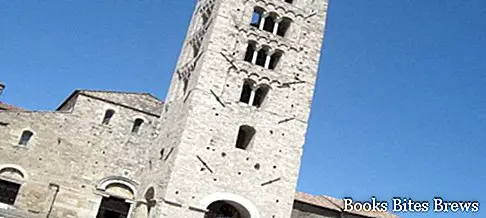What to see in Anagni, itinerary including the main monuments and places of interest in the city of the Popes, including Cathedral of Santa Maria, Palazzo Bonifacio VIII, Church of Sant'Andrea, Palazzo comunale and Casa Barnekow.
Tourist information
Located in Lazio in the province of Frosinone, Anagni is located on a tuff spur placed in a dominant position on the valley of the Sacco river.
It became dominion of the Romans in 306 BC, later it was submitted first to Ravenna and then to the Papal State, until it became a free municipality in the twelfth century.
Anagni is called the city of the Popes, as some Popes, Gregory IX, Alexander IV and Boniface VIII, were born there.
The Cathedral of Santa Maria, built between 1072 and 1104, is one of the best examples of the Romanesque Lazio style, with subsequent addition of Gothic motifs.
In front of the facade, detached from the Church, there is the bell tower.
The interior of the Cathedral has three naves, ending with Lombard-style apses and having a thirteenth-century pavement.
Very interesting are the Museum, where there are numerous archaeological finds, and the treasure of the Cathedral.
The Palazzo di Bonifacio VIII, built on commission of Gregorio IX, later passed to the Caetani.
The facade is characterized by a large loggia with arches and mullioned windows, while inside there are some frescoed rooms, including the one nicknamed "the slap", famous for being the place where the historic "Anagni outrage" took place.
What see
The Palazzo del Comune, dating back to the twelfth century, is supported by eight imposing arches and two smaller, very interesting for its elegance and particularity is the fifteenth-century Loggia del Banditore.
Recommended readings- Anagni (Lazio): what to see
- Lazio: Sunday day trips
- Vetralla (Lazio): what to see
- Ciociaria (Lazio): what to see in the historic region
- Alatri (Lazio): what to see
The Romanesque Church of Sant'Andrea, affected by renovations carried out in the late Baroque period, shows a mullioned bell tower, while inside there is the Gothic triptych of the Santissimo Salvatore.
Casa Barnekow is a typical Romanesque house, having a staircase covered by two arches, while the exterior is decorated with nineteenth-century paintings.
Among the excursions to do in the surrounding area is that of Segni, a locality about fifteen kilometers away, located on the slopes, covered with woods, of the Lepini mountains, which dominate the Sacco valley.
Segni corresponds to the ancient Volsca city of Signia, which later passed to the Romans.
After it was annexed to the possessions of the Papal States, the town became a fief first of the Counts of Segni, then of the Sforza-Cesarini.
In the highest part of the inhabited center you can see the imposing polygonal walls, dating back to the period between the sixth and fifth century BC, developed for about two kilometers, which open at the Saracen Gate, characterized by huge square stones, positioned in so as to create a pointed arch, truncated at its top.
In the acropolis there are the remains of a third century BC temple, erected on a previous temple, some traces of which are still visible.
In the place where the main cell of the temple stood there is the Church of San Pietro, dating back to the thirteenth century but remodeled in the eighteenth century, which preserves the original bell tower.
In the Cathedral there are interesting works of art, including a painting by Pietro da Cortona and one by Borgognone.




